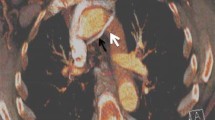Summary
A left retro-aortic brachiocephalic vein is a rare anatomic entity. A retrospective study was made of 5218 congenital cardiopathies treated between 1982 and 1998 in a medico-surgical department of paediatric cardiology. A left retro-aortic brachiocephalic vein was demonstrated in 27 patients, i.e. an incidence of 0.5%. The chief cardiopathy in these patients was a tetralogy of Fallot in 25 cases (93%). Among these 25 cases of Fallot's tetralogy the aortic arch was rightsided in 19 cases (70%). The paraclinical diagnosis of this anomaly was facilitated by ultrasonography, provided it was sought for. In this series 6 cases (22%) were discovered during surgery without previous ultrasound diagnosis. The embryological origin of the left retro-aortic brachiocephalic v. differs from that of the venous trunk in its classical anatomic form. It derives from the inferior (but not superior) transverse plexuses, connecting the two anterior cardinal veins. One of the main consequences of this anomaly is its possible confusion with other vascular structures, particularly the right pulmonary artery. Such confusion may give rise to inappropriate surgical procedures. The differential diagnosis is facilitated by the use of the Doppler: the venous flow is biphasic and regulated by respiration, whereas the Doppler recording from a pulmonary artery is that of a characteristic systolic arterial flow.
Résumé
La veine brachiocéphalique gauche rétro-aortique est une entité anatomique rare. Une analyse rétrospective a été réalisée sur 5 218 cardiopathies congénitales traitées entre 1982 et 1998 dans un département médico-chirurgical de cardiologie pédiatrique. Une veine brachiocéphalique gauche rétro-aortique a été mis en évidence chez 27 patients soit une incidence de 0,5 %. La cardiopathie principale était une tétralogie de Fallot dans 25 cas (93 %). Parmi ces 25 cas de tétralogie de Fallot, l'arc aortique était droit dans 19 cas (70 %). Le diagnostic paraclinique de cette anomalie est aisé par échocardiographie à condition de la rechercher. Dans cette série, 6 cas (22 %) ont été découverts pendant la chirurgie sans diagnostic échographique préalable. L'origine embryologique de la veine brachiocéphalique gauche rétro-aortique est différente de celle de la v. brachiocéphalique dans sa forme anatomique classique. Elle provient des plexus transverses inférieurs (et non supérieurs) mettant en communication les deux veines cardinales antérieures. Une des principales conséquences cliniques de cette anomalie est la confusion possible avec d'autres structures vasculaires en particulier l'a. pulmonaire droite. Une telle confusion peut être à l'origine d'indications chirurgicales non appropriées. Le diagnostic différentiel est facilité par l'utilisation du Doppler : le flux veineux est biphasique et rythmé par la respiration alors que l'enregistrement Doppler d'une a. pulmonaire donne un flux artériel systolique caractéristique.
Similar content being viewed by others
References
Bartoli JM, Chagnauaud C, Moulin G, Di Stefano-Louineau D, Bory M, Kasbarian M (1990) Pseudocoarctation of the aorta associated with retro-aortic left brachiocephalic vein: a case report. Surg Radiol Anat 12: 307–309
Cha EM, Khoumi GH (1972) Persistent left superior vena cava. Radiologic and clinical significance. Radiology 103: 375–381
Choi JY, Jung MJ, Kim YH, Noh CI, Yun YS (1990) Anomalous subaortic position of the brachiocephalic vein (innominate vein): an echocardiographic study. Br Heart J 64: 385–387
Cloez JL, Ravault MC, Maron F, Pernot C (1982) Tronc veineux innomin en position sous aortique: intrt de lÕchographie de contraste par voie suprasternale. Arch Mal CÏur 8: 939–943
Fujimoto K, Abe T, Kumabe T, Hayabuchi N, Nosaki Y (1992) Anomalous left brachiocephalic (innominate) vein: MR demonstration. AJR 159: 479–480
Gerlis LM, Ho SY (1989) Anomalous subaortic position of the brachiocephalic (innominate) vein: a review of published reports and report of three new cases. Br Heart J 61: 540–545
Kerschner L (1888) Zur Morphologie der Vena Cava Inferior. Anatomischer Anzeiger 3: 808–823
Mill MR, Wilcox BR, Detterbeck FC, Anderson RH (1993) Anomalous course of the left brachiocephalic vein. Ann Thorac Surg 55: 600–602
Smallhorn JF, Zielinsky P, Freedom RM, Rowe RD (1984) Abnormal position of the brachiocephalic vein. Am J of Cardiology 55: 234–236
Yana C, Frija J, Helenon O, Lard D, Martin-Bouyer Y, Laval-Jeantet M (1988) Le tronc veineux brachio-cphalique gauche rtro-aortique. Une anomalie rare: deux cas. J Radiol 69: 281–284
Author information
Authors and Affiliations
Rights and permissions
About this article
Cite this article
Curtil, A., Tronc, F., Champsaur, G. et al. The left retro-aortic brachiocephalic vein: morphologic data and diagnostic ultrasound in 27 cases. Surg Radiol Anat 21 (Suppl 4), 251–254 (1999). https://doi.org/10.1007/BF01631395
Received:
Accepted:
Issue Date:
DOI: https://doi.org/10.1007/BF01631395




